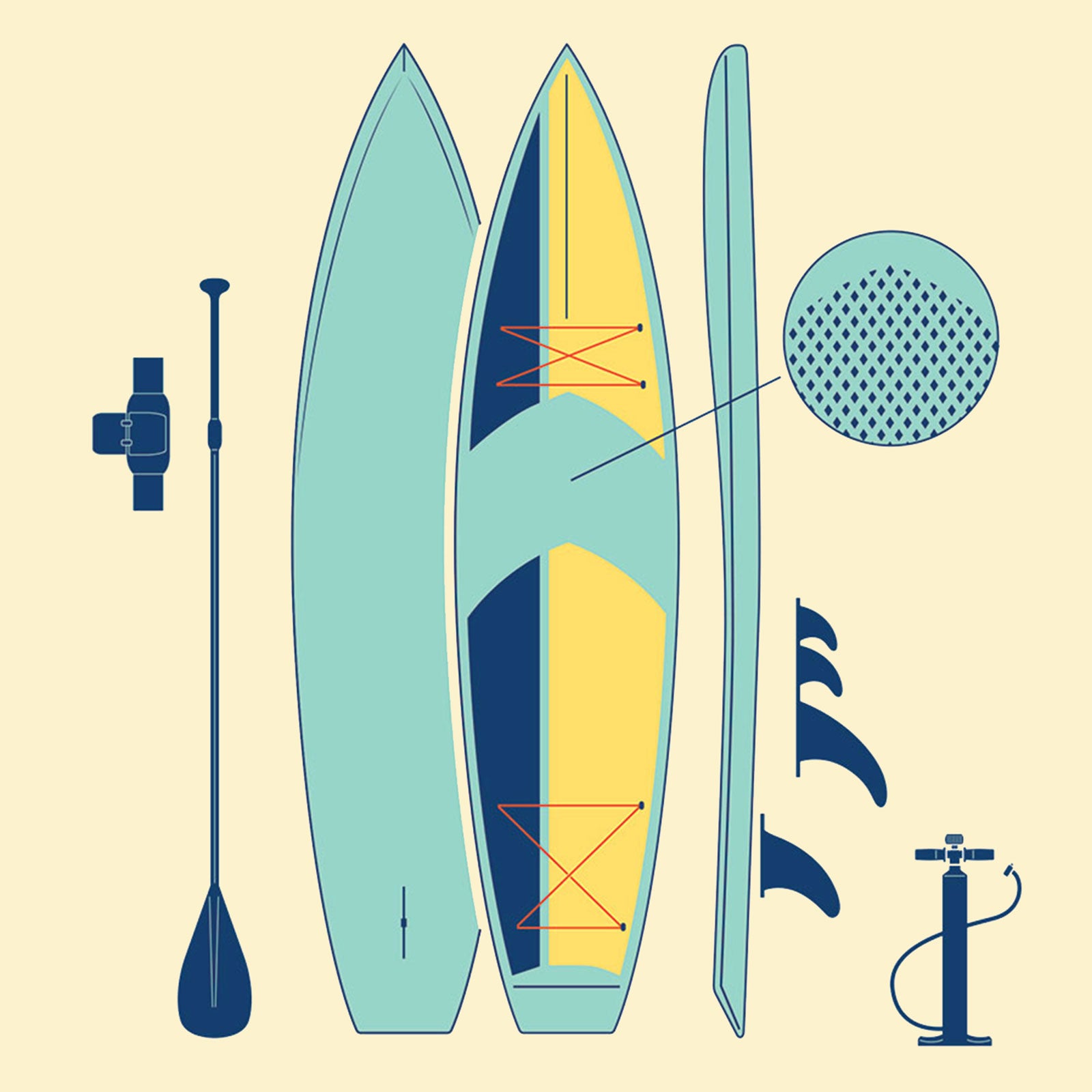Shape
A paddleboard’s shape determines how it will perform and the conditions it will excel in. Designs have been tailored for everything from fishing to navigating whitewater, so before you buy a board, consider what you want to do on it. For speed and efficiency when paddling, the pointed nose and flat underside of displacement hulls are best. For maneuverability and stability, the low-profile curves and wide, upturned nose of planing hulls are a good choice. Retailers as well as board manufacturers often specialize in a single type of paddling. Look for a shop or brand that knows about your chosen discipline.
Construction
There’s no single correct way to build a board, but there are usually trade-offs. Focus your search on the features you want, then consider the benefits and drawbacks of the board as a whole. Materials like carbon fiber will decrease weight but increase cost, while wood veneer will make a board stronger but also heavier. Inflatable SUPs come in a variety of shapes and lengths, are durable, and are excellent for the storage challenged. Rigid models are responsive when gliding or surfing and, with a few exceptions, tend to paddle more efficiently than their air-filled counterparts. But many rigid models are more expensive, and they’re impossible to cram into the back of a sedan.
Length
More than anything else, a board’s length affects its maneuverability, whether it’s an 18-foot race board or an eight-foot whitewater SUP. For smaller paddlers, an unnecessarily long board can be difficult to turn. And a board that’s too short won’t track straight. Many models come in a variety of sizes. Surf and whitewater SUPs usually fall into the eight-to-ten-foot range, allowing for quick maneuvering. Touring and all-around models often measure ten to twelve feet, which offers solid buoyancy and the ability to carry some gear. Race boards and long-distance tourers are between 12 and 14 feet, which keeps them narrow, for better glide on the water, without sacrificing buoyancy.
Width
Width determines a board’s overall stability. In general, wider boards are stabler. That’s why beginner models often run between 30 and 36 inches across. (Professional race boards can be as narrow as 23 inches.) Depending on the hull shape, width can also impact glide and efficiency. Typically, wider boards have more drag. Think about the conditions you’ll be paddling in. If you plan to be on the ocean, a wider board is better at handling swell and chop. For glassy lake paddling, a fast and narrow board excels.
Volume
Measured in liters, volume indicates a board’s buoyancy and how much weight it can carry. A touring board can have a volume of up to 300 liters, allowing a paddler to load enough gear onto it for multi-day trips. Surf SUPs have the least volume (often less than 100 liters), making them smaller and more maneuverable. There’s no secret formula for how many liters a board should be. Factors to consider are your own body weight and the kind of paddling you’ll be doing. More volume means a heavier board, and that might be a burden to transport and difficult to move on the water.
Weight
Generally, more expensive boards are lighter, but they also tend to be less durable. That’s not always the case, of course. Look for boards that are built with quality materials, whatever they happen to weigh. Race boards are often made with carbon fiber—the lightest material available—and can weigh as little as 20 pounds. Heavier wood veneer and fiberglass, plastic, and inflatable PVC are more durable but may tip the scales at 30 pounds or more.
Fins
Most boards come equipped with one or more fins. Fin shape and layout will play into a board’s tracking and maneuverability: three- and four-fin combinations, which help a board track even when it isn’t lying flat on the surface, tend to be better for surfing, while longer and wider single fins are more efficient for touring and racing. Something to watch out for: the fin slots used on certain boards are the manufacturer’s own propriety design, which could lock you into buying their fins if you lose one.
Deck Pad
SUPs are almost always topped with a deck pad, usually a flat piece of closed-cell foam or cork. The deck pad is important because it’s your interface with the board. A good one should match the board’s intended activity. Surf SUPs have an elevated tail block to brace your foot against when making quick turns. Touring boards have pads that cover much of the deck, easing movement fore and aft. If possible, try out a few varieties to see how different patterns and foam densities affect your comfort.
Price
Paddleboards can range from $500 for a basic inflatable to $19,000 for a one-of-a-kind, hand-built work of art. The vast majority of both inflatable and rigid boards cost between $800 and $2,000.


